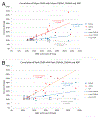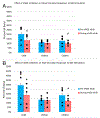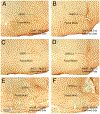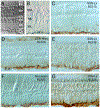Role of the superior salivatory nucleus in parasympathetic control of choroidal blood flow and in maintenance of retinal health
- PMID: 33736985
- PMCID: PMC8087653
- DOI: 10.1016/j.exer.2021.108541
Role of the superior salivatory nucleus in parasympathetic control of choroidal blood flow and in maintenance of retinal health
Abstract
The vasodilatory pterygopalatine ganglion (PPG) innervation of the choroid is under the control of preganglionic input from the superior salivatory nucleus (SSN), the parasympathetic portion of the facial motor nucleus. We sought to confirm that choroidal SSN drives a choroid-wide vasodilation and determine if such control is important for retinal health. To the former end, we found, using transscleral laser Doppler flowmetry, that electrical activation of choroidal SSN significantly increased choroidal blood flow (ChBF), at a variety of choroidal sites that included more posterior as well as more anterior ones. We further found that the increases in ChBF were significantly reduced by inhibition of neuronal nitric oxide synthase (nNOS), thus implicating nitrergic PPG terminals in the SSN-elicited ChBF increases. To evaluate the role of parasympathetic control of ChBF in maintaining retinal health, some rats received unilateral lesions of SSN, and were evaluated functionally and histologically. In eyes ipsilateral to choroidal SSN destruction, we found that the flash-evoked scotopic electroretinogram a-wave and b-wave peak amplitudes were both significantly reduced by 10 weeks post lesion. Choroidal baroregulation was evaluated in some of these rats, and found to be impaired in the low systemic arterial blood pressure (ABP) range where vasodilation normally serves to maintain stable ChBF. In retina ipsilateral to SSN destruction, the abundance of Müller cell processes immunolabeled for glial fibrillary acidic protein (GFAP) and GFAP message were significantly upregulated. Our studies indicate that the SSN-PPG circuit mediates parasympathetic vasodilation of choroid, which appears to contribute to ChBF baroregulation during low ABP. Our results further indicate that impairment in this adaptive mechanism results in retinal dysfunction and pathology within months of the ChBF disturbance, indicating its importance for retinal health.
Keywords: Autonomic; Choroidal blood flow (ChBF); Parasympathetic; Retinal degeneration; Superior salivatory nucleus (SSN).
Copyright © 2021 The Authors. Published by Elsevier Ltd.. All rights reserved.
Conflict of interest statement
Declarations of competing interest
None.
Figures












Similar articles
-
Defective Choroidal Blood Flow Baroregulation and Retinal Dysfunction and Pathology Following Sympathetic Denervation of Choroid.Invest Ophthalmol Vis Sci. 2018 Oct 1;59(12):5032-5044. doi: 10.1167/iovs.18-24954. Invest Ophthalmol Vis Sci. 2018. PMID: 30326072 Free PMC article.
-
Anatomical and functional evidence for progressive age-related decline in parasympathetic control of choroidal blood flow in pigeons.Exp Eye Res. 2005 Oct;81(4):478-91. doi: 10.1016/j.exer.2005.03.008. Epub 2005 Jun 1. Exp Eye Res. 2005. PMID: 15935343
-
Stimulation of Baroresponsive Parts of the Nucleus of the Solitary Tract Produces Nitric Oxide-mediated Choroidal Vasodilation in Rat Eye.Front Neuroanat. 2016 Oct 7;10:94. doi: 10.3389/fnana.2016.00094. eCollection 2016. Front Neuroanat. 2016. PMID: 27774055 Free PMC article.
-
Neural control of choroidal blood flow.Prog Retin Eye Res. 2018 May;64:96-130. doi: 10.1016/j.preteyeres.2017.12.001. Epub 2017 Dec 8. Prog Retin Eye Res. 2018. PMID: 29229444 Free PMC article. Review.
-
Sub-foveal choroidal blood flow by LDF: measurement and application to the physiology and pathology of the choroidal circulation.Bull Soc Belge Ophtalmol. 2006;(302):185-94. Bull Soc Belge Ophtalmol. 2006. PMID: 17265798 Review.
Cited by
-
Ocular Autonomic Nervous System: An Update from Anatomy to Physiological Functions.Vision (Basel). 2022 Jan 14;6(1):6. doi: 10.3390/vision6010006. Vision (Basel). 2022. PMID: 35076641 Free PMC article. Review.
-
Stress-induced impairment of parasympathetic NO-mediated inhibition of sympathetic vasoconstriction in submucosal arteriole of rat rectum.Pflugers Arch. 2024 Oct;476(10):1555-1570. doi: 10.1007/s00424-024-02990-5. Epub 2024 Jul 18. Pflugers Arch. 2024. PMID: 39023562
-
Effect of FFP2/N95 facemask wear on retinal and choroidal thickness profile in healthy subjects.Int J Ophthalmol. 2022 Nov 18;15(11):1821-1828. doi: 10.18240/ijo.2022.11.13. eCollection 2022. Int J Ophthalmol. 2022. PMID: 36404981 Free PMC article.
-
Parasympathetic innervation of emmetropization.Exp Eye Res. 2022 Apr;217:108964. doi: 10.1016/j.exer.2022.108964. Epub 2022 Feb 1. Exp Eye Res. 2022. PMID: 35120871 Free PMC article.
-
The Essential Role of the Choriocapillaris in Vision: Novel Insights from Imaging and Molecular Biology.Annu Rev Vis Sci. 2022 Sep 15;8:33-52. doi: 10.1146/annurev-vision-100820-085958. Annu Rev Vis Sci. 2022. PMID: 36108103 Free PMC article. Review.
References
-
- Alm A, 1992. Ocular circulation. In: Hart WM (Ed.), Adler’s Physiology of the Eye: Clinical Application. Mosby, St Louis, pp. 198–227.
-
- Bill A, 1985. Some aspects of the ocular circulation. Invest. Ophthalmol. Vis. Sci 26, 410–424. - PubMed
Publication types
MeSH terms
Grants and funding
LinkOut - more resources
Full Text Sources
Other Literature Sources
Miscellaneous

